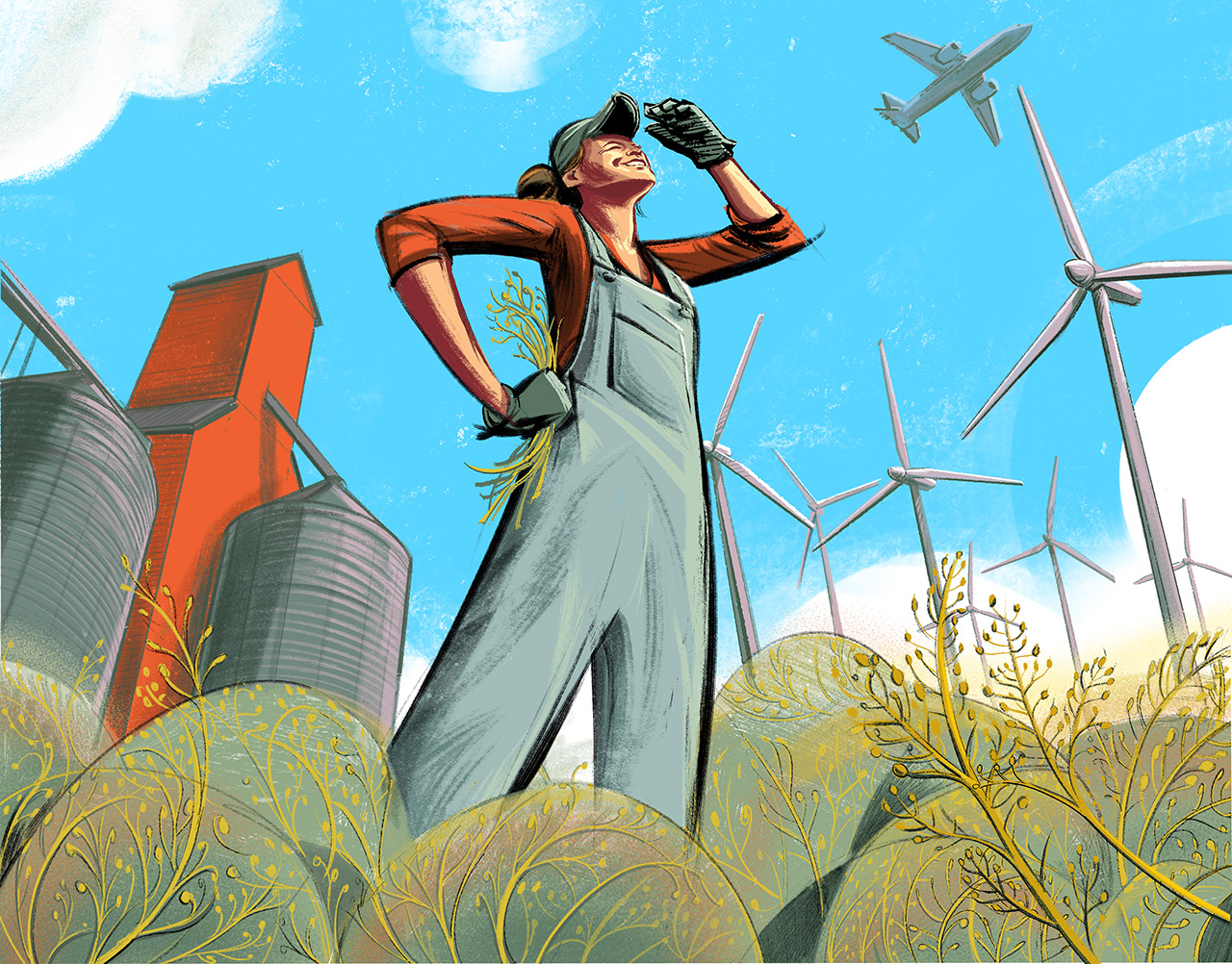
In a Nutshell:
– Sustainable Aviation Fuel (SAF) is an innovative, lower-carbon alternative to traditional jet fuel.
– The SAF production process involves converting feedstocks like annual winter oilseeds and renewable electricity into fuel, processing and blending the fuel, and using it to power airplanes.
– Minnesota is an ideal location for SAF development due to its abundant feedstocks, existing infrastructure, and strong market demand.
– Minnesota’s policy landscape is already supporting the creation of a SAF industry with federal incentives, state-based tax credits, and forward-thinking clean energy laws.
– Building a SAF industry in Minnesota offers a sweeping opportunity to lower emissions, promote equitable economic growth, and lead the nation in a transition to a decarbonized economy.
As we confront the complexities of the climate crisis, it’s clear that reducing emissions across all sectors — electricity generation, transportation, residential and commercial buildings, heavy industry, and agriculture — is essential. While Minnesota has made great strides in decarbonizing electricity generation and is taking steps toward decarbonizing buildings and vehicle transportation, one area within the transportation sector remains particularly stubborn: aviation. Airplanes, which are responsible for nearly 10 percent of the transportation sector’s greenhouse gas emissions in the U.S., present a unique challenge. Unlike cars or buses, most planes can’t simply switch to clean-powered batteries due to their weight. This is where Sustainable Aviation Fuel (SAF) comes into play.
SAF is a promising tool in our toolkit for reducing aviation emissions. SAF has lower lifecycle emissions than traditional jet fuel, which means we can pivot the airline industry to emit far fewer emissions in the near-term. Importantly, SAF is the only commercially-available and scalable technology we currently have that can significantly reduce emissions in the aviation industry, making it a crucial area of focus as we work toward broader climate goals.
But SAF isn’t just about cleaner skies. Its development also ties into the agricultural and clean electricity sectors: One promising way to develop SAF is to use Minnesota-grown winter annual oilseeds like camelina and pennycress as its raw material, which allows us to simultaneously decrease emissions in Minnesota’s agriculture sector and support regenerative farming practices. This offers potential benefits like new, innovative revenue streams for farmers and rural communities, as well as improvements in land use and air and water quality. Another promising way to develop SAF is to use renewable electricity, water, and carbon dioxide to develop a liquid fuel (known as Power-to-Liquid, Power-to-Jet, and Power-to-X) with lower emissions than jet fuel. This pathway offers potential benefits in that it is not reliant on bio-based feedstocks and takes advantage of Minnesota’s abundant renewable electricity generation, spurring the strategic deployment of green hydrogen fuels.
As we look to the future, Minnesota is poised to play a leading role in developing a SAF industry, since we uniquely have the existing systems and infrastructure to begin developing SAF, potentially becoming a hub for SAF innovation and production for other states to replicate.
In this blog post, we’ll dive into the details of SAF — what it is, how it’s made, and why Minnesota is an ideal place for its development. We’ll also explore the policy landscape that will shape the creation of a SAF hub in the state, and why building a SAF marketplace correctly is so important for both our climate goals and our economy. Let’s dive in!
What is sustainable aviation fuel (SAF)?
Sustainable Aviation Fuel is a next-generation fuel source for airplanes that’s designed to lower the carbon emissions associated with air travel. Unlike traditional jet fuel, which is derived entirely from fossil fuels, SAF can be produced from a variety of sources — like renewable electricity, waste materials, or bio-based regenerative agriculture products like camelina — resulting in significantly-reduced lifecycle greenhouse gas emissions.
While SAF doesn’t eliminate all emissions, it allows us to significantly lower emissions in the aviation industry quickly, which is important — it’s not just essential to decarbonize Minnesota by midcentury to avoid the worst impacts of climate change, but to also lower cumulative emissions as quickly as possible, too. SAF is a crucial tool toward lowering aviation emissions — an industry that can’t easily transition to clean-powered batteries due to weight constraints.
By using SAF, the aviation sector can reduce its carbon emissions and other negative environmental impacts, making it a vital piece in the broader effort to combat climate change. SAF is a cleaner alternative than jet fuel that will help us bridge the gap as we work toward carbon-free solutions and full decarbonization.
How is sustainable aviation fuel made?
SAF begins with the production of feedstocks, which are the raw materials used to generate the fuel. These feedstocks can be derived from a variety of sources, including renewable electricity, waste materials, and even bio-based products like winter oilseeds and camelina. Once produced, these feedstocks are processed and blended with other fuels to create SAF, which is then transported to airports like the Minneapolis-Saint Paul (MSP) International Airport, where it can be used to power airplanes. The key innovation in SAF lies in the selection of feedstocks, which determines the carbon intensity of the final product.
There are numerous methods to produce SAF, with new fuel pathways being researched and developed continuously. Methods include Power-to-Liquid, which uses renewable electricity to produce green hydrogen which is blended with water and CO2 into liquid fuel, and Alcohol-to-Jet, which relies on corn ethanol to be produced. Another category of SAF feedstocks is Hydroprocessed Esters and Fatty Acids (HEFA), where oils, such as those from camelina or winter oilseeds or soybeans, are converted into SAF. HEFA can also be produced synthetically in a lab, adding another layer of innovation to SAF production.
SAF production is an evolving industry with multiple pathways under exploration. Each method offers different advantages and challenges, and it’s important to test these approaches through pilot projects to figure out which ones work the best at reducing emissions and improving ecosystems. The diversity of fuel pathways makes SAF production a complex topic, but it also presents opportunities for innovation and economic development here in Minnesota. By adhering to our robust Guiding Principles, which we developed alongside Friends of the Mississippi River and The Nature Conservancy, we can ensure that SAF not only lowers emissions but also contributes positively to our environment and communities. As the industry is built, grows, and matures and successful technologies are scaled up, it’s important we get it right from day one to ensure equity, sustainability, and innovation are developed well as we decarbonize the aviation industry.
What is a SAF hub?
A SAF hub is a collaborative initiative designed to accelerate the development, production, and adoption of SAF within a specific region. Minnesota’s SAF Hub, recently launched by GREATER MSP in partnership with Bank of America, Delta Air Lines, Ecolab, and Xcel Energy, is a prime example of a hub. This multi-year effort aims to aggressively decarbonize the airline industry by making SAF more affordable, abundant, and environmentally responsible. The hub brings together industry leaders, state agencies, and nonprofits to create a robust SAF market that not only supports Minnesota’s greenhouse gas (GHG) emissions reduction targets but also drives innovation and economic development across the state.

Why is Minnesota a good state for a SAF hub?
Minnesota is an ideal location to develop SAF due to our rich availability of feedstocks that can be used to test and produce SAF locally. From bio-based sources like camelina and winter oilseeds to green hydrogen produced from renewable electricity and carbon dioxide, Minnesota offers a diverse range of raw materials that are essential for creating SAF. Additionally, we have a well-established rail network that can efficiently and safely transport these fuels, further supporting the development of a robust SAF supply chain.
Moreover, Minnesota already has existing blending facilities that could be retrofitted to produce SAF, and the MSP International Airport provides a motivated buyer for the fuel. With key players like Delta, Ecolab, and Cargill showing strong interest, Minnesota possesses all the necessary components — feedstocks, infrastructure, and market demand — to serve as a prime testing and production ground for SAF. If successful, the model established here could be replicated in other states, advancing the broader goal of decarbonizing aviation.
What’s the policy landscape for creating a SAF hub in Minnesota?
Establishing a SAF hub in Minnesota is complex and promising, and several key policies support and influence its development. Federal incentives, such as the Inflation Reduction Act’s tax credits, play a critical role in encouraging industries to invest in SAF. These credits help to lower the financial barriers to entry, making it more feasible for companies to innovate and scale SAF production. However, creating a successful SAF hub in Minnesota isn’t just about securing funding; it’s about aligning this development with the state’s broader goals of decarbonizing transportation, agriculture, and the power sector.
Minnesota’s policy landscape is particularly conducive to SAF development due to its strong commitment to clean energy and environmental sustainability. The state has already established a robust framework for reducing emissions across sectors, which is crucial for the development of bio-based feedstocks for SAF. Minnesota’s 100% clean electricity law, which was preceded by successful policies like the Renewable Energy Standard and Next Generation Energy Act, sets an ambitious timeline to decarbonize the power sector, which is also essential to powering the development and production of SAF in the state, which will rely on clean electricity.
Furthermore, other policy mechanisms in Minnesota will play a crucial role in the development of SAF. Market-based fuel policies like the Clean Transportation Standard (or Low Carbon Fuel Standard, enacted in California, Oregon, and Washington, and explored in Minnesota during its 2023 and 2024 legislative sessions) would provide a Minnesota-based framework of incentives that would stack with Federal tax credits. Additionally, the Minnesota Legislature passed $11.6 million in funding for a state-based SAF Fuel Credit in 2023, making both producers and blenders eligible for incentives from 2024 to 2030. Finally, the upcoming Farm Bill has the potential to accelerate the development and adoption of alternative feedstocks like winter annual oilseeds.
SAF: Here’s how we can get it right
Getting the policy right is critical. As highlighted in our “Guiding Principles” document, the risks of not properly aligning SAF market development with Minnesota’s clean energy transition are significant. Missteps could exacerbate emissions, contribute to groundwater and air pollution, and ultimately slow down the decarbonization process in the transportation and agriculture sectors. This is why it’s essential to adopt a nuanced approach that balances innovation with sustainability, ensuring that SAF development contributes positively to the environment and communities.
Additionally, Minnesota must also prioritize investments in economic justice and equity as part of its SAF strategy. By doing so, the state can ensure that the benefits of SAF development are distributed fairly, particularly to historically underserved communities. This includes creating opportunities for economic growth and workforce development in regions that could benefit the most. By aligning SAF market development with Minnesota’s clean energy transition and focusing on equity, Minnesota can lead the way that responsibly reduces emissions and promotes a just, decarbonized future.
Minnesota has a critical opportunity to dramatically lower emissions, equitably invest in our communities, and continue our reputation in building a clean energy economy that allows Minnesotans to thrive. It’s essential that Minnesota’s SAF industry is built to benefit all Minnesotans and our environment.
Further Reading:
- Sustainable Aviation Fuels: How we can get it right
- Minnesota Sustainable Aviation Fuels Guiding Principles | Fresh Energy, Friends of the Mississippi River, The Nature Conservancy
- Refueling Aviation in the US: Evolution of US Sustainable Aviation Fuel Policy | RMI
